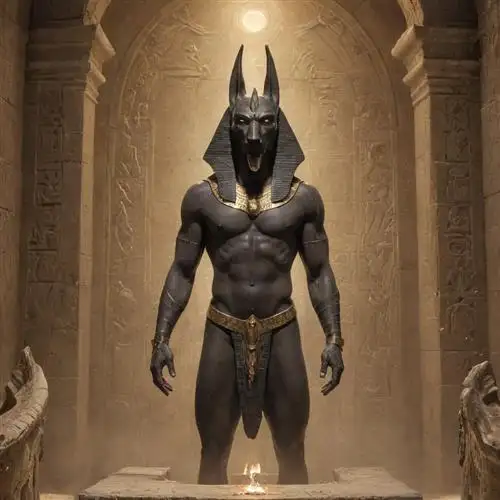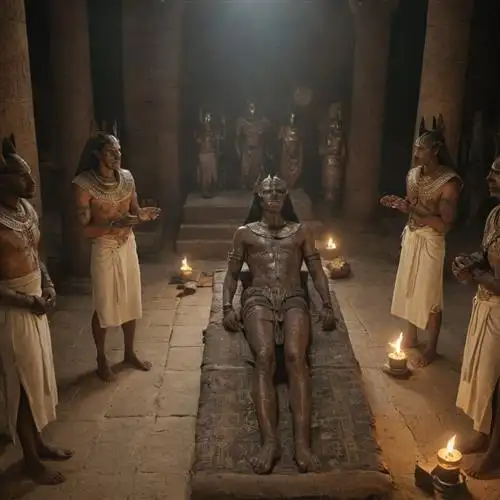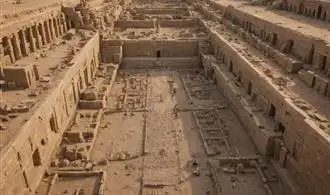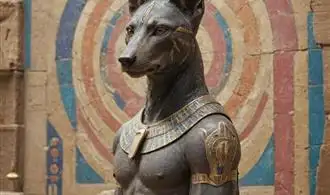
Anubis The Jackal God
Anubis, the ancient Egyptian deity associated with mummification and the afterlife, is a captivating figure that has long captivated the imagination of scholars and enthusiasts alike. As the jackal-headed god, Anubis played a crucial role in the Egyptian belief system, guiding the dead through the perilous journey into the afterlife and overseeing the mummification process.
At the heart of Anubis' mythology is his role as the conductor of the dead, responsible for leading the deceased into the afterlife and ensuring the integrity of the mummification process. During the elaborate funerary rituals, Anubis would stand vigil over the mummy, protecting it from harm and guiding the soul of the deceased into the next realm. This profound responsibility cemented Anubis' status as a pivotal figure in the Egyptian pantheon, as the faithful turned to him for guidance and protection during the most critical moments of their spiritual journey.
Interestingly, Anubis' association with the jackal was not merely symbolic but also rooted in the natural world. Jackals were often observed scavenging in cemeteries, leading the ancient Egyptians to associate these creatures with the world of the dead. Anubis, with his jackal-like features, was believed to embody the characteristics of these animals, serving as a bridge between the realms of the living and the dead.
The rituals and ceremonies associated with Anubis were equally captivating, with the mummification process being a prime example. Anubis would oversee the intricate process of preserving the body, ensuring that the deceased were prepared for their journey into the afterlife. This attention to detail and reverence for the dead was a hallmark of the ancient Egyptian belief system, and Anubis was at the very heart of these practices.
Beyond his role in the afterlife, Anubis was also believed to possess a range of other powers and abilities. He was sometimes depicted as a protector of the living, guarding them from harm and offering guidance during times of spiritual need. Additionally, Anubis was associated with the judgment of the dead, weighing the hearts of the deceased against the feather of truth to determine their worthiness for the afterlife.
The Role of Anubis in the Afterlife
Anubis, the jackal-headed god of ancient Egyptian mythology, played a vital role in the journey of the deceased through the afterlife. As the guardian of the underworld and the embalmer of the dead, Anubis was responsible for ensuring the safe passage of the soul from the physical world to the realm of the divine.
One of the most important functions of Anubis was the process of mummification. He was believed to have taught the ancient Egyptians the art of preserving the body, a crucial step in preparing the deceased for the afterlife. By removing the internal organs and drying the body, Anubis ensured that the physical form remained intact, allowing the soul to return to it upon resurrection.
In the final judgment of the dead, Anubis played a central role. He was responsible for weighing the heart of the deceased against the feather of Ma'at, the goddess of truth and justice. If the heart was found to be lighter than the feather, the soul was deemed worthy and allowed to pass into the afterlife. If the heart was heavier, the soul was devoured by the demon Ammit, condemning the individual to eternal oblivion.
Anubis also guided the deceased through the various challenges and obstacles they would face in the afterlife. He was believed to accompany the soul on its journey, providing protection and offering guidance to ensure a successful transition to the next world. This included guiding the soul through the treacherous underworld, helping the deceased to navigate the complex and often confusing landscape of the afterlife.
The importance of Anubis in the afterlife was reflected in the extensive funerary rituals and practices of ancient Egypt. Statues and amulets of Anubis were often placed in tombs and alongside the deceased, symbolizing his role as the protector and guide of the soul. Additionally, the jackal-headed god was invoked in various funerary spells and incantations, further highlighting his significance in the journey to the afterlife.
Mummification and the Journey to the Afterlife
In ancient Egyptian mythology, Anubis was the god associated with mummification and the journey to the afterlife. The process of mummification was a meticulously planned and executed ritual, designed to ensure the deceased's successful transition to the afterlife. This intricate process involved several key steps that were crucial to the deceased's journey.
The first step in mummification was the removal of the internal organs. This was done with great care and precision, as these organs were believed to be essential for the afterlife. The brain was removed through the nostrils, while the other organs were removed through an incision in the abdomen. These organs were then placed in canopic jars, which were believed to be guarded by the four sons of Horus.
After the removal of the internal organs, the body was dried using a salt-like substance called natron. This process could take several weeks, during which the body was carefully monitored and maintained. Once the body was sufficiently dried, it was wrapped in linen bandages, a process that could take several days to complete.
The wrapping of the body was not just a practical necessity but also a symbolic representation of the deceased's journey to the afterlife. Each layer of linen was believed to represent a different aspect of the deceased's spiritual journey, and the wrapping process was carefully choreographed to ensure the successful completion of this journey.
The final step in the mummification process was the placement of amulets and talismans within the wrappings. These objects were believed to provide the deceased with protection and guidance on their journey to the afterlife. Some of the most common amulets included the scarab beetle, which was associated with the sun god Ra, and the ankh, which represented the key to eternal life.
Once the mummification process was complete, the deceased was placed in a coffin or sarcophagus, which was often elaborately decorated with hieroglyphics and images of the gods. These decorations were believed to provide the deceased with the necessary knowledge and guidance to navigate the afterlife successfully.
The journey to the afterlife was not a simple one, and the ancient Egyptians believed that the deceased would face a series of challenges and obstacles along the way. The most well-known of these was the weighing of the heart, where the deceased's heart was weighed against the feather of Maat, the goddess of truth and justice. If the heart was found to be pure and righteous, the deceased would be granted eternal life in the afterlife.
Anubis and the Judgement of the Dead
In ancient Egyptian mythology, Anubis, the jackal-headed god, played a pivotal role in the process of the judgement of the dead. As the guardian of the dead and the embalming process, Anubis was responsible for escorting the souls of the deceased to the Hall of Judgement, where their worthiness was determined.
The judgement of the dead was a crucial ritual in ancient Egyptian belief, as it determined the fate of the individual in the afterlife. The process was centered around the weighing of the deceased's heart against the feather of Ma'at, the goddess of truth and justice. This ceremony, known as the "Weighing of the Heart," was presided over by Anubis, who would carefully observe the proceedings and ensure the fairness of the judgement.
If the heart of the deceased was found to be pure and free from sin, it would balance perfectly with the feather of Ma'at, signifying that the individual had lived a righteous life. In this case, the soul would be permitted to move on to the afterlife, where it would enjoy eternal peace and happiness.
However, if the heart was found to be heavier than the feather, it indicated that the individual had committed misdeeds or led an unworthy life. In this scenario, the soul would be condemned to the underworld, where it would face a variety of punishments and torments.
Anubis, with his keen understanding of the afterlife and the judgement process, played a crucial role in guiding the souls of the deceased through this pivotal ritual. His presence and oversight ensured that the judgement was carried out with the utmost fairness and impartiality, ensuring that the deceased received the appropriate fate based on their actions in life.
Rites and Rituals Honoring Anubis
Rites and Rituals Honoring Anubis, the Jackal-Headed God, have been an integral part of ancient Egyptian spiritual practices for millennia. As the god of mummification, the afterlife, and the guardian of the dead, Anubis played a pivotal role in the journey of the deceased through the underworld.
One of the most significant rituals associated with Anubis was the mummification process. During this sacred ceremony, the body of the deceased was carefully prepared and transformed into a vessel for the soul to reside in the afterlife. The embalmers, known as "Seshmu," would invoke the power of Anubis to ensure a successful and seamless transition for the departed.
Another important ritual was the "Opening of the Mouth" ceremony, which was performed to restore the deceased's ability to speak, breathe, and partake in the offerings in the afterlife. This ritual involved the use of special tools, incantations, and the invocation of Anubis to "open the mouth" of the mummy, allowing the soul to communicate with the living.
In addition to these funerary rites, the ancient Egyptians also honored Anubis through various forms of temple worship and personal devotion. Temples dedicated to Anubis were often located near necropolises, where the dead were buried, and served as centers of ritual and pilgrimage. Within these temples, the faithful would make offerings, perform purification rituals, and seek the guidance and protection of the jackal-headed god.
One of the most intriguing aspects of Anubis worship was the use of canine or jackal-headed statues and amulets, which were believed to invoke the power and presence of the deity. These objects were often placed in tombs or carried by the living as talismans, serving as a tangible connection to the supernatural realm and the guidance of Anubis.















